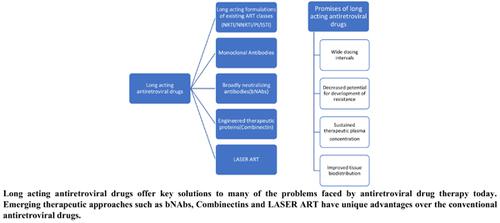Current HIV Research ( IF 1 ) Pub Date : 2020-12-31 , DOI: 10.2174/1570162x18666200824104140 Rajpushpa Labh 1 , Rachna Gupta 1

|
Antiretroviral drug therapy has significantly improved the prognosis and life expectancy of people living with HIV over the years. But this progress comes with an important caveat that antiretroviral regimens generally require adherence to life-long, daily dosing, to keep viral multiplication under check. Non-adherence to such dosing leads to decreased efficacy and increased drug resistance against antiretroviral drugs. Besides, poor drug penetration to certain tissues like CNS and lymph nodes leads to the build-up of viral reservoirs in these sites. To combat some of these challenges and improve patient compliance, long-acting antiretroviral drugs, are a new weapon in the arsenal, in the fight against HIV. Few long-acting preparations have been approved, and several others are in various clinical and preclinical stages of development. However, long-acting formulations also have their share of clinical issues like limited drug distribution, long term adverse drug reactions, drug-drug interactions, and gradual development of drug resistance. Modern technological premises are being tested to mitigate some of these problems. One such promising approach involves nanotechnological methods, which are being used to develop ultra-long acting formulations and drug delivery systems, targeting tissues with residual HIV concentration. Long-Acting Slow Effective Release Antiretroviral Therapy aka LASER ART, also builds on nanotechnology and prodrug modifications to design preparations with tailor-made favorable pharmacokinetics and wider drug distribution. These recent advances are fueling the progression of antiretroviral therapy towards eliminating the disease.
中文翻译:

长效抗逆转录病毒疗法的新趋势:现状和治疗挑战
多年来,抗逆转录病毒药物治疗显着改善了艾滋病毒感染者的预后和预期寿命。但这一进展伴随着一个重要的警告,即抗逆转录病毒疗法通常需要坚持终生每日给药,以控制病毒增殖。不遵守这种给药方式会导致疗效降低和抗逆转录病毒药物耐药性增加。此外,药物对某些组织(如 CNS 和淋巴结)的渗透性差会导致病毒库在这些部位积聚。为了应对其中一些挑战并提高患者的依从性,长效抗逆转录病毒药物是抗击 HIV 的新武器。很少有长效制剂获得批准,其他几种制剂正处于不同的临床和临床前开发阶段。然而,长效制剂也有一些临床问题,如药物分布有限、药物长期不良反应、药物相互作用和耐药性的逐渐发展。正在测试现代技术前提以减轻其中一些问题。一种这样有前景的方法涉及纳米技术方法,该方法被用于开发超长效制剂和药物递送系统,靶向具有残留 HIV 浓度的组织。长效缓释抗逆转录病毒疗法又名 LASER ART,也建立在纳米技术和前药修饰的基础上,以设计具有量身定制的有利药代动力学和更广泛药物分布的制剂。这些最近的进展正在推动抗逆转录病毒疗法朝着消除这种疾病的方向发展。并逐渐产生耐药性。正在测试现代技术前提以减轻其中一些问题。一种这样有前景的方法涉及纳米技术方法,该方法被用于开发超长效制剂和药物递送系统,靶向具有残留 HIV 浓度的组织。长效缓释抗逆转录病毒疗法又名 LASER ART,也建立在纳米技术和前药修饰的基础上,以设计具有量身定制的有利药代动力学和更广泛药物分布的制剂。这些最近的进展正在推动抗逆转录病毒疗法朝着消除这种疾病的方向发展。并逐渐产生耐药性。正在测试现代技术前提以减轻其中一些问题。一种这样有前景的方法涉及纳米技术方法,该方法被用于开发超长效制剂和药物递送系统,靶向具有残留 HIV 浓度的组织。长效缓释抗逆转录病毒疗法又名 LASER ART,也建立在纳米技术和前药修饰的基础上,以设计具有量身定制的有利药代动力学和更广泛药物分布的制剂。这些最近的进展正在推动抗逆转录病毒疗法朝着消除这种疾病的方向发展。用于开发超长效制剂和药物输送系统,靶向具有残留 HIV 浓度的组织。长效缓释抗逆转录病毒疗法又名 LASER ART,也建立在纳米技术和前药修饰的基础上,以设计具有量身定制的有利药代动力学和更广泛药物分布的制剂。这些最近的进展正在推动抗逆转录病毒疗法朝着消除这种疾病的方向发展。用于开发超长效制剂和药物输送系统,靶向具有残留 HIV 浓度的组织。长效缓释抗逆转录病毒疗法又名 LASER ART,也建立在纳米技术和前药修饰的基础上,以设计具有量身定制的有利药代动力学和更广泛药物分布的制剂。这些最近的进展正在推动抗逆转录病毒疗法朝着消除这种疾病的方向发展。


























 京公网安备 11010802027423号
京公网安备 11010802027423号